Stefan Slater

‘You still in the racket?’ he asked.
‘You mean am I still in the same game?’
‘Sure. Use your loaf. What the hell else would I mean?’
‘Yes. There’s nothing else for it when you’ve once been inside.’
One screwsman to another. Fresh out of Wormwood Scrubs after a nine-months spell in stir for housebreaking, twenty-five-year-old William Kennedy, known as the Gilt Kid on account of his blond hair, is a young man determined not to go straight. The Gilt Kid. An exploration of a world of petty criminals, ponces, poufs, prostitutes and heavy-fisted policemen in London’s West End; the cancer at the heart of Empire. A slice of hardboiled film noir.
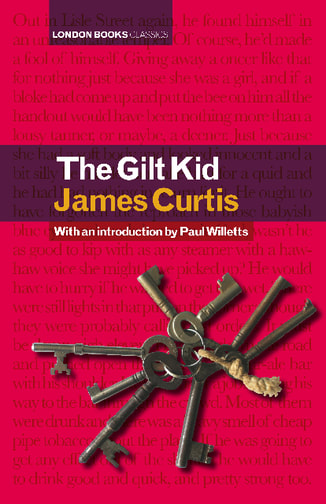 Published in 1936, The Gilt Kid chimes with the end of an era. Victorian and Edwardian avatars, Rudyard Kipling and George V, show their colours, and die. Dead but not banished. Shadows of Dickens and Mayhew, Conan Doyle, Conrad and Robert Louis Stevenson stalk the scene. A life on the margins, a world of five-penny ales, lizzie (cheap Lisbon red wine), Gold Flake cigarettes, the public bar, seedy cafés and coffee stalls. More than 30,000 souls eking their living off the streets. A London living on borrowed time, the death knell signalled by the Blitz, her demise hastened by the affluent society.
Published in 1936, The Gilt Kid chimes with the end of an era. Victorian and Edwardian avatars, Rudyard Kipling and George V, show their colours, and die. Dead but not banished. Shadows of Dickens and Mayhew, Conan Doyle, Conrad and Robert Louis Stevenson stalk the scene. A life on the margins, a world of five-penny ales, lizzie (cheap Lisbon red wine), Gold Flake cigarettes, the public bar, seedy cafés and coffee stalls. More than 30,000 souls eking their living off the streets. A London living on borrowed time, the death knell signalled by the Blitz, her demise hastened by the affluent society.
For ‘London had become a city of flats’, so said Sir Austen Chamberlain, MP. Take Hammersmith, the borough of the Scrubs, where Kennedy commits his crime. A place with its own hidden histories: murder and suicide off the Hammersmith Bridge, shady clubs and Fascists meeting at the town hall. Hints of decay, middle-class flight to the suburbs. An area clinging desperately to its vanishing respectability. Early echoes of post-45 high-rise crime-blight:
The block of flats was built of red brick and the inner walls of the staircase were made of those white glazed tiles with which public lavatories and police-court cells are built. Their feet sounded hollowly on the stone steps. There was a nasty iron handrail. The flats were obviously for the lower middle class. It was unlikely that any of them contained anything worthy of a burglar’s time or attention. …
It’s funny, he was thinking. Every one of these gaffs holds a family. Each family is cut off from the others. Nobody has the foggiest what is going on anywhere else. They read the crime news in the papers and get a thrill out of seeing a film about crooks, yet if they were to know that a couple of burglars were walking up their main staircase they would fall down dead with fright.
Forget the making of modern London, the whiff of America – metroland, milk bars and the motor car; radio and refrigeration, Selfridges and Woolworths, the Savoy and the Ritz, the nightclub and the cinema. Curtis’s London is an experience in cold truth. Victorian ghosts, the marginal stage centre.
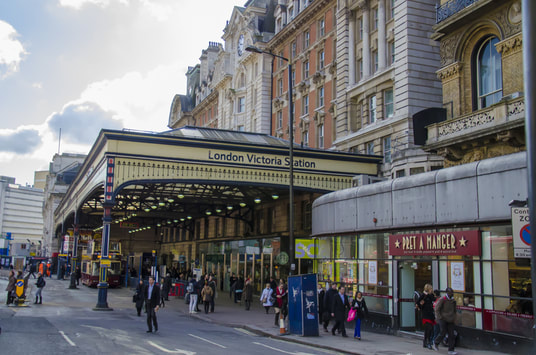
Suffused with an aura of decline, the Gilt Kid’s home life is centred around the shabby gentility of his cheap furnished lodgings in Pimlico – ‘the houses, for one thing, had been built for far wealthier people than were living in them’ – and the cheerful vulgarity of the environs of Victoria, a downmarket red-light district on the wane, a step down from the Lisle Street janes, patronized by soldiers stationed at the many local barracks and commuters. All that glitters is not gold:
The market stalls in Warwick Street, which at night added a vivid gaiety to the street scene, looked by day merely squalid. The ground around them was littered with bits of paper and cabbage leaves. Pale, harassed-looking women, for the most part with string-bags hanging from their arms, stared either at the stalls or into the windows of the cut-price shops; spinning their money out as best they could, they would be buying cheap tinned salmon, condensed milk, hard soaplike Canadian cheese, and salt-encrusted, badly cured Empire bacon. Those who scorned margarine would purchase imitation imported butter at tenpence a pound. On Saturdays they could get cheap scraps of dusty meat from the stalls. Few, if any, ate real food.
Hardly the glam of the smash-and-grab kings Ruby Sparks and Billy Hill. Hill has much to answer for. An imaginative man. Watch out for Duncan Webb too. You can’t trust a journalist. Or a policeman.
Curtis is a guide to the lowlife, his characters companions to Patrick Hamilton’s whores, Gerald Kersh’s pathetic ponce Fabian and Robert Westerby’s small-time race gangs; all authors with more than a degree of experience of the worlds which they narrate. Neither a Home Counties whodunit, nor an underworld of misremembered celebrity gangsters before their time.
 Darby Sabini, ‘Britain’s Godfather’ according to an ex-Daily Express hack, who had long-left London by the thirties, was immortalized by Graham Greene as Colleoni in Brighton Rock. Hoxton thug Jimmy Spinks, who may or may not have thrown the chip shop owner’s cat into the deep-fat fryer when asked to pay for his supper, as Richard Attenborough’s Pinky. A seventeen-year-old kid. Juvenile delinquent in-extremis. Spinky the great-uncle of bare-knuckle fighter Lenny McClean, of Lock and Stock cameo fame. See Curtis’s complaint to Curtis Clark, a producer at Raintree who had an option on the Gilt Kid:
Darby Sabini, ‘Britain’s Godfather’ according to an ex-Daily Express hack, who had long-left London by the thirties, was immortalized by Graham Greene as Colleoni in Brighton Rock. Hoxton thug Jimmy Spinks, who may or may not have thrown the chip shop owner’s cat into the deep-fat fryer when asked to pay for his supper, as Richard Attenborough’s Pinky. A seventeen-year-old kid. Juvenile delinquent in-extremis. Spinky the great-uncle of bare-knuckle fighter Lenny McClean, of Lock and Stock cameo fame. See Curtis’s complaint to Curtis Clark, a producer at Raintree who had an option on the Gilt Kid:
An elementary error in dramatic construction is the way those Mafia characters are dragged in at the heel of the hunt. […] The so-called Sabini mob from Clerkenwell in the 30s were Anti-Fascist and, though of Italian parentage, were thoroughly Cockney in speech and behaviour. They operated mainly around the Races and Dog tracks.
Take Isabella’s, a café, a ‘ribby kind of a gaff’ in Lisle Street – the haunt of ‘drabs’ the lowest of Soho’s generally poor prostitutes – on the fringes of the Italian quarter centred on and around Newport Dwellings, Newport Buildings, Gerrard, Frith and Old Compton Streets:
At the top end an Irish girl was sitting with two men, both of whom wore striped suits with wide, padded shoulders. One of them had a north-country accent. All three of them were talking in low vehement tones. They were, apparently, having a row about something of another. Money or women. Very likely the two.
The Gilt Kid ran a disapproving eye over them. He did not like these Grecian cows. They swore like navvies, drank like fishes, and fought like hell among themselves. They always picked up with ponces, usually Yids, and then turned them down for another bloke. That was probably what the barney was about now. Both the men looked as if they might be on the Jo Roncing stakes. Irish janes were good to fellows on the bum and to the boys on the gagging lark, he’d heard somewhere.

An antidote to the alzheimic golden memories of Frankie Fraser, Freddie Foreman and the Krays, myths retold by ex-journalists, Edward Hart and Duncan Webb, the staple of ‘true-crime’ historians, Brian McDonald, James Morton, Robert Murphy and Donald Thomas.
London, the city of the dispossessed, more Stephen Graham’s London Nights than John Bull or the News of the World. More downtrodden than deviant. The illusion of freedom shrouds this city of dreadful delight:
The pavements were crowded, girls hung on men’s arms, laughed up in their faces. A sound of laughter, a buzz of conversation, a busy rattle of glasses issued out from all the public houses. He was companionless. He could, naturally, if he wanted to do so, go into a bar and help to increase its hum; he could, if he wanted to do so, pick up a girl, even a straight-cut, and have her walk arm-in-arm with him. What was the use? He would have only purchased companionship in the bar by virtue of the money in his pocket, he would only have a girl hanging on his arm because he was a man and she craved male society in order to show off in front of her friends. In cold truth, nobody in the world cared a damn about him. He was as lonely here, at liberty in the streets of London, as ever he had been, sitting on the floor of his locked cell in prison sewing mailbags. It was a hell of a life.
A man marked, the Gilt Kid avoids underground stations, he’s a ‘suspicious person’. No chances, no choices, the future written on him. At mercy to the streets: ‘He spread, with a characteristic gesture, his long thief’s fingers fanwise on the bar in front of him and then, noticing their ingrained grime and the black rims of his nails, hastily hid them from sight.’ A man determined. Just as Marx said.
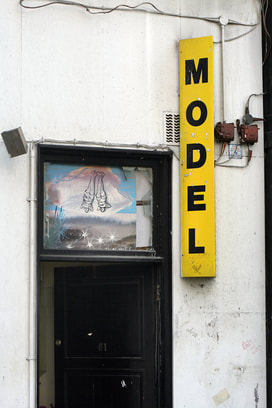
The Gilt Kid ‘wanted to be a good communist but it seemed to him that all this theorizing was rot.’ He despairs with the Left, moaning to a vendor of the Daily Worker:
‘Listen, you hold demonstrations,’ he began, ‘meetings, hunger-marches and all that bull. What the hell good does it do? Just a few mugs get nicked and a few more have sore heads where the slops have bashed them with their batons. You can’t tell me that brings the revolution any nearer.’
… ‘Start a riot. Lead a row in Bond Street and loot all the shops. Collect all the bums in London and take them into one of the flash hotels and let them demand to be fed. You hear about hunger-marchers making rows and demanding grub. Where’d they go? To the Ritz, to Lyons’ Corner House, even? No! The workhouse. That’s just about your mark, kicking up a shine at the spike.
Life went on to imitate art when in November 1938, 200 men descended on the Ritz Grill and ‘demanded tea for tuppence.’ May Day. Call the police.
‘Bastards. All bogies were bastards’, a not unpopular view in more than a few of London’s working-class districts. Police as Law, the ever-present threat of the truncheon. Memories die hard. Violence echoing from the hunger marches through to Cable Street, and beyond. The Gilt Kid ‘could remember back in stir that when people said that Justice was blind, they really meant that it shut one eye.’
There’s only one way to be heard. ‘He’d lost seven days’ remission in prison for hitting a cleaner whom he thought to be carving him up over his rations.’ Teased by a lousy Victoria Station tart for not being able to get it up, the Gilt Kid threatens her with ‘a kick in the minge if you don’t shut up.’ Brute force as Law:
The policeman caught the connecting link of the Gilt Kid’s handcuffs and yanked him to his feet. He dodged, bounded forward between the uniformed men at the detective and, raising his hands above his head, dashed the heavy steel into the startled officer’s face. Before he fell to a sledgehammer blow behind on the back of his neck he had the joy of seeing blood spurt all over his victim’s face.
Crook and copper, both products of the same streets. All know their place, suffocated by the stench of class:
A street-hawker came into the bar. He kept his goods – razor blades, cards of studs, boot-laces, safety pins and ties – in a cheap suitcase made of paper grained to look like leather. The management here, as in most other public houses, would allow him only into the public bar. Public bar customers were only working men and having, for the most part, less money than the harlots and petit bourgeois in the saloon, were entitled to be worried by the importunities of hawkers and street musicians.
Most of them stared the hawker blankly in the face when he held his open suitcase in front of them; some turned their heads away as if they did not care to look upon the unholy sight of a poor man earning his bed for the night …Poor bastards, none of them was far above the poverty line himself. Some of them, maybe, would have to go hungry as a result of having drunk a couple of pints of fivepenny ale.
The language of class imprisons all. Waiting to come up before the beak at the police court, the Gilt Kid:
looked disgustingly at his fellow prisoners. There were four of them, all bums. They were just the sort of people who gave the boys a bad name and started people chucking off hot air about the ‘lower criminal classes’. One was up for begging, one for obstruction with a coster’s barrow, the third for hawking without a license, and the fourth for bashing his old lady. Not one of them a decent screwsman could chat with.
Those at the bottom of the pile haunt the Gilt Kid. A down-and-out world of screevers (pavement artists), gaggers (generic street performers), nobbers (collecting coins for beggars), chanters (street singers), clodhoppers (street dancers), mugfakers (street photographers), didecais (gypsys) and tobys (tramps). For the tramp is his shadow, and his fate. The Gilt Kid has seen:
The worst of rooms was better than the best of kips. And the worst of kips was better than being properly on the ribs. Christ, yes, he thought, I’d rather be back in stir again than have another night on the deck. One of those had been quite enough.
Creeping around the place all night, sitting on the seats in Trafalgar Square and along the Mall until it had been too cold to stay seated any longer; and then walking about to get warm until his feet, blistered from broken boots and sweat-rotten socks, had grown too sore to let him walk any more; sitting down again until it was too cold, and so on until five o’clock when the café opened in St Martin’s Lane – that café where they charge three-ha’pence for a cup of tea and let a man sit for two hours or more over it.
Of course, some bums touch lucky, they manage to forget their misery, the cold and their red-rimmed sleepless eyes, by dropping off for a few minutes till a policeman comes along and wakes them up. Crowds of them lie every night on that little triangle of grass behind the Admiralty Arch which they called the Cabbage Patch.
The Cabbage Patch, where John Worby sees ‘dozens of men and women of all types sprawled out on the grass.’ Orwell’s ‘prostitutes and men lying in couples there in the bitter cold mist and dew.’ Details, grist to documentary fiction.
And it is to Trafalgar Square, the emblem of Empire, where in October 1921Wal Hannington and other members of the newly-formed National Unemployed Workers’ Movement unfurled the Red Flag from the plinth of Nelson’s Column, that the Gilt Kid’s fate is sealed.
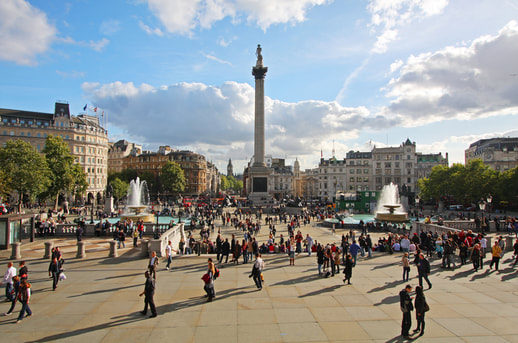
Trafalgar Square, where the Gilt Kid meets Jimmy Nunn, an ex-lag. A bum. The Gilt Kid’s guide and his future. Of whom the Gilt Kid learns the tricks of the trade. The secrets of the beggar’s parcel: old shirts, a couple of empty tins, old newspapers, brown paper to keep off rheumatism. And the box full of kerbstone twists – recycled tobacco fetched three pence an ounce on the streets –‘long, short, broken, some flattened with the impress of a careless heel, some idly thrown away with only a puff or two drawn out of them. The Gilt Kid made a vow never again to tread on an unwanted cigarette end.’ Of their kin, the Gilt Kid had spent his time penniless on London’s benches. He belongs with those on the crook:
They got too old for the game and had to end their lives sitting about in Trafalgar Square and on the Embankment. That was, unless they touched real lucky and went down for a long time. Five years’ penal servitude and seven years’ preventive detention. Some copped that. They died in Camp Hill instead of coughing their lungs up under Hungerford Bridge. It was a bastard whichever way you looked at it.
True crime feeds a willing market. Fictions weaved from Fleet Street, memory and the official report. Policing at the expense of the police, lived experience sacrificed to the cult of the fact. Tear down the idols and dare to read the re-forgotten. Along with Patrick Hamilton’s The Midnight Bell, Gerald Kersh’s Night and the City and Robert Westerby’s Wide Boys Never Work, James Curtis in the Gilt Kid strips away the underworld’s seductive garments, relishing the cruelty.
Stefan Slater’s affinity for the world in which he writes means that he isn’t cut out for corporate life. Following a failed attempt at a career in academia, Stefan now pulls pints in a Surrey pub.
James Curtis
James Curtis (1907-77) was born in Kent as Geoffrey Maiden. He boarded at King’s School, Canterbury. As Curtis’s novels make clear, he rejected the mores of his upbringing and embraced left-wing politics. The Gilt Kid was his first book. Other works included You’re In the Racket Too (1937), There Ain’t No Justice (1937) and, his most popular book, They Drive By Night (1938). The latter two novels were made into films, with Curtis being involved in the writing of both screenplays.
What Immortal Hand (1939) was not so well received; his subsequent, and final, novel Look Long Upon A Monkey not appearing until 1956. Interest in Curtis was revived by the publishing house London Books. Recent critics place the works of Curtis alongside the ‘proletarian school’ of writers such as Leslie Halward, Patrick Hamilton and John Hampson. His novels provided a rich source for the pioneering slang lexicographer Eric Partridge.
As to Curtis’s personal life, the details are somewhat sketchy. Possessing the air of a gentleman, he could be enthusiastic and impulsive. According to his daughter, he didn’t suffer fools gladly and could be very bad tempered. A difficult man to live with.
Curtis had more than a streak of outrage at the social injustices of his society and was an avid supporter of the IRA. He ‘did his bit’ and saw active service during the Second World War, but this placed additional strains on family life. Following the collapse of his marriage, he offered no financial support to his daughter or ex-wife.
A man who more than enjoyed a drink, a fag and a flutter, Curtis went on to develop late-onset diabetes. Once again, life imitates art, for this middle-class man who immersed himself in the life he wrote about, spent his twilight years in a bedsit.
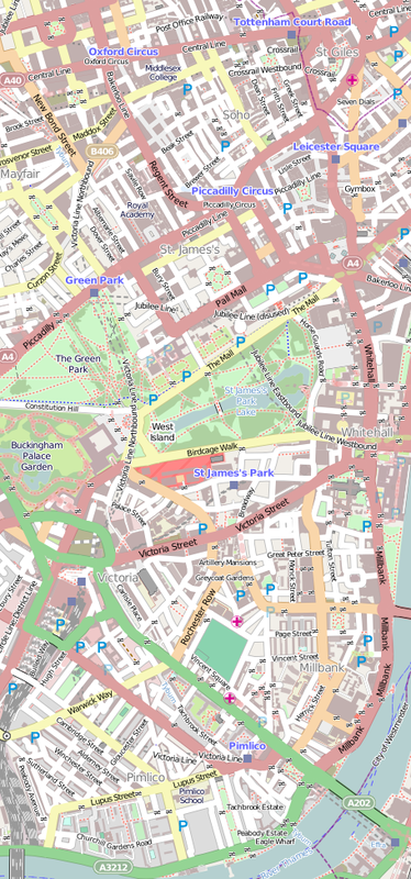
References and Further Reading: Exploring London 1918-39
The time is ripe for travelling through the capital between the wars. While the maps are not as detailed as those charting the Victorian period, there are markers to aid the virgin explorer.
Ken Worpole’s Dockers and Detectives (Nottingham: Five Leaves, 2nd edn, 2008) is one of the first guides to draw attention to London’s rich popular literature. For a brief introduction to such novels see Merlin Coverley’s London Writing (Harpenden: Pocket Essentials, 2005). Our capital visions are a collision of fiction, memory, myth and history. A quirky yet poetic meditation on these themes lies in Iain Sinclair, Lights Out for the Territory (London: Penguin, 2003). The novels considered in my essay include:
- James Curtis, The Gilt Kid, intro. Paul Willetts (London: London Books, 2007 [1936])
- ________ They Drive by Night, intro. Jonathan Meades (London: London Books, 2008 [1938])
- Graham Greene, Brighton Rock, intro. J.M. Coetzee (London: Vintage, 2004 [1938])
- Patrick Hamilton, Twenty Thousand Streets under the Sky, intro. Michael Holroyd (London: Vintage, 2010 [1935])
- Gerald Kersh, Night and the City, intro. John King (London: London Books, 2007 [1938])
- John Sommerfield, May Day, intro. John King (London: London Books, 2010 [1936])
- Robert Westerby, Wide Boys Never Work, intro. Iain Sinclair (London: London Books, 2008 [1937])
Day-to-day snapshots of London were garnered from The Times. The grainy photographs and commentary captured in Paul Cohen-Portheim’s, The Spirit of London (London: Batsford, 2011 [1935]) are a useful complement. No London explorer can fail to ignore the London School of Economics’ nine volume New Survey of London Life and Labour (1930-35), in particular S.K. Ruck, ‘The Street Trading Community’, in Hubert L. Smith (ed.), The New Survey of London Life and Labour, Vol. 3: Survey of Social Conditions (1) The Eastern Area (London: P.S. King & Son Ltd, 1932). Further anthropological insights were gleaned from George Orwell’s Down and Out in Paris and London (London: Penguin, 2013 [1933]) and his diaries (The Orwell Diaries, ed. Peter Davison [London: Penguin, 2010]). Stephen Graham’s haunting London Nights: A Series of Studies and Sketches of London at Night (London: Hurst & Blackett, 1925) is essential reading.
Anyone interested in London lowlife cannot fail to avoid the, at times, fantastic memories of this period. The following were consulted for this essay:
- Frankie Fraser and James Morton, Mad Frank: Memoirs of a Life of Crime (London: Little, Brown, 1994)
- Graham Greene, Ways of Escape (London: Bodley Head, 1980)
- Billy Hill, Boss of Britain’s Underworld (Hornchurch: Billy Hill Family Ltd, 2008 [1955])
- Brian Magee, Clouds of Glory: A Hoxton Childhood (London: Pimlico, 2004)
- John Worby, The Other Half: The Autobiography of a Spiv (London: J.M. Dent & Sons, 1937)
The above are a staple source for the burgeoning ‘true crime’ market. While such histories are light on meaning and interpretation, the authors deserve congratulation for raising the profile of London’s seamier side. The more fascinating include:
- Edward T. Hart, Britain’s Godfather (London: True Crime Library, 1993)
- Brian McDonald, Gangs of London: 100 Years of Mob Warfare (Wrea Green: Milo, 2010)
- James Morton, Gangland Soho (London: Piatkus, 2008)
- Robert Murphy, Smash and Grab: Gangsters in the London Underworld, 1920-60 (London: Faber and Faber, 1993)
Following in the footsteps of Clive Emsley, the pioneer of police history, a number of historians have looked at this period with a more critical eye, see especially:
- Heather Shore, ‘“Undiscovered County”: Towards a History of the Criminal “Underworld”’, Crimes and Misdemeanours, 1 (2007), 42-68
- _______ ‘Criminality and Englishness in the Aftermath: The Racecourse Wars of the1920s’, Twentieth Century British History, 22, 4 (2011), 474-97
- Stefan Slater, ‘Prostitutes and Popular History: Notes on the “Underworld”, 1918-1939’, Crime, Histoire & Sociétés/Crime, History and Societies, 13, 1 (2009), 25-48
- John Carter Wood, ‘“The Third Degree”: Press Reporting, Crime Fiction and Police Powers in 1920s Britain’, Twentieth Century British History, 21, 4 (2010), 464-85
